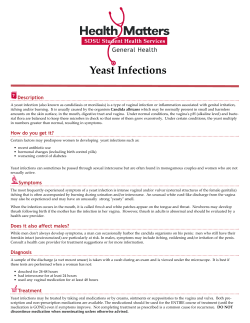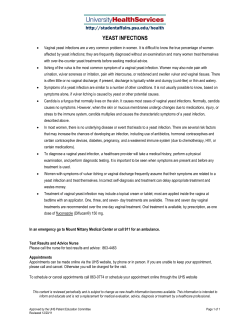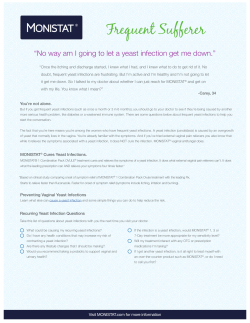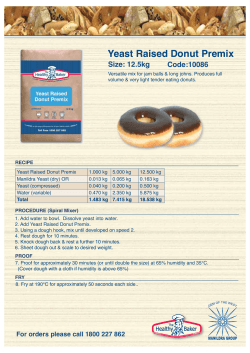
Fact Sheet
UNIVERSITY STUDENT HEALTH SERVICES • Fact Sheet VAGINAL CANDIDIASIS (YEAST INFECTION) WHAT IS IT? Vaginal yeast infections are caused by a fungus called Candida. Yeast normally lives in small numbers on the skin and inside the vagina. It typically does not cause problems unless conditions become favorable for its overgrowth. While Candida albicans is the most common species of yeast that causes vaginal irritation, the incidence of non-albicans Candida is increasing. HOW COMMON IS IT? It is estimated that three out of four women experience at least one yeast infection during their lifetime. At least half of these women will experience at least one recurrence. WHAT CAUSES IT? Many bacteria grow in the vagina of a healthy woman. Some of these bacteria work to promote an acidic environment that keep yeast and other organisms from multiplying. Certain predisposing factors can lead to a rise in the vaginal pH, which increases the risk of a yeast infection. These include: • Pregnancy, diabetes, illness, allergic reactions • Antibiotics, steroid medication, birth control pills • Tight, poorly ventilated clothing; poor hygiene • Cuts, abrasions, and other irritants in the vagina (from insufficient vaginal lubrication during sex, tampon use, feminine sprays or douches, bath oils, strong soaps, etc.) • Excessive carbohydrate intake (especially unrefined sugars) • Generalized decrease in immune resistance (from stress, lack of sleep, poor diet) WHAT ARE THE SYMPTOMS? • The most common symptom is itching or burning in and around the vagina. • The discharge is usually thick and white (like cottage cheese) but may also be watery. Sometimes there is no discharge at all. • Some women experience redness and/or swelling around the vaginal area, soreness, pain with sex, and/or burning with urination. IS IT SEXUALLY TRANSMITTED? Vaginal yeast infections are not considered sexually transmitted infections, although the infection may rarely be passed from one partner to another. Most experts do not recommend treatment of a sexual partner. Women who are sexually active are more likely to have a yeast infection, but women who have never been sexually active can get it as well. Yeast infections may also develop more frequently in women who receive oral sex. Male partners usually do not experience any symptoms. However, they may experience a rash and/or a burning sensation if condoms are not used. These symptoms usually resolve without treatment. HOW IS IT DIAGNOSED? To accurately diagnose a yeast infection, a pelvic exam is necessary. A sample of vaginal discharge is examined under the microscope for the presence of yeast. It is important to obtain an accurate diagnosis as yeast symptoms can mimic other vaginal infections. WHAT IS THE TREATMENT? Yeast infections usually respond well to creams or oral medications that are specifically active against Candida. • Antifungal vaginal creams. A variety of over-the-counter and prescription vaginal creams are available. One-, three- and seven-day treatments are equally effective. More severe infections will require longer treatments. It is important to complete the entire treatment course to prevent a relapse. • Antifungal pills. The antifungal pill Diflucan (fluconazole) is a convenient form of treatment. It is taken by mouth as a one-time dose. More than one dose may be recommended for women with severe or recurrent infections. Diflucan is not usually recommended during the first trimester of pregnancy due to the potential risk of harm to the fetus. • Pill + Cream. Using an antifungal cream in addition to Diflucan is recommended when irritation of the skin around the vagina is a prominent symptom. For example, apply over-the-counter (non-vaginal) miconazole cream to the skin outside of the vagina twice daily to decrease skin symptoms. • Herbal remedies. Some women, particularly those with chronic symptoms, have found herbal therapies to be helpful. There is little clinical evidence proving the effectiveness of these therapies despite their success in some cases. Examples include: - Teas (goldenseal, echinacea, and - Probiotic supplements phytolacca) - Boric acid capsules - Acidophilus (1/2 tsp twice a day or - Garlic pills or juice yogurts with “live active cultures”) - Tea tree oil douches WHEN WILL I FEEL BETTER? Most yeast infections go away within a few days after starting treatment. However, itching and irritation may continue even after the infection is gone. If you are not better a few days after finishing treatment, contact your medical provider. HOW CAN I PREVENT IT? Clothing: • Avoid tight pants and undergarments. • Wear 100% cotton underwear. Avoid underwear made of synthetic material, thongs, and pantyhose. Sleeping without underwear may also be helpful. • Change out of wet gym clothes or bathing suits as soon as possible. Personal Care: • Substitute showers for tub baths. Avoid soaking in bath salts, oils, or strong soaps. • Gently but thoroughly dry the genital area after showering, bathing, or swimming. • Wipe from front to back in order to prevent transfer of bacteria to the vagina. • Limit the use of scented pads, liners, and baby wipes. • Avoid scented or colored toilet paper. • Do not douche unless it is recommended by your medical provider. Diet: The exact relationship between diet and infection is not completely understood; however, the following suggestions may be helpful: • Reduce your intake of all sugars, both refined and natural (as in fruit or fruit juices). • Restrict mold- and yeast-containing foods (eg. alcohol, cheese, dried fruits, peanuts). • Cut back on dairy products, refined white flour, mushrooms, and fermented foods (vinegar and wine). • Limit carbohydrates to no more than 100 grams daily. RECOMMENDED WEBSITES: www.cdc.gov, www.familydoctor.org, www. mayoclinic.com ____________________________________________________________________________ Published by VCU Division of Student Affairs and Enrollment Services University Student Health Services (804) 828-8828 - Monroe Park Campus clinic (804) 828-9220 - MCV Campus clinic Wellness Resource Center (804) 828-9355 - 815 S. Cathedral Place Revised 6/13
© Copyright 2025





















